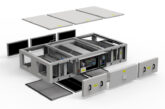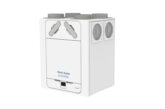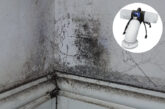
Housebuilder Lovell Homes has selected Vent-Axia’s Lo-Carbon Sentinel Kinetic Cooker Hood MVHR (Mechanical Ventilation with Heat Recovery) and the Lo-Carbon NBR dMEV C (decentralised Mechanical Extract Ventilation) as part of its Tomorrow Home project at Cornish Park in Spennymoor, County Durham.
The Tomorrow Home project consists of demonstration homes built to test alternative electric heating systems directly against each other, as well as assessing the effective performance of a range of sustainable technologies, including ventilation.
Tomorrow Home features two identical, three-bedroom, semi-detached homes that have been built to an interpretation of the anticipated Future Homes Standard, with improved building fabric. In one of the three-bedroom homes a Vent-Axia Lo-Carbon Sentinel Kinetic Cooker Hood MVHR has been installed, the other has been fitted with Lo-Carbon NBR dMEV C. Lovell Homes are working with Teesside University and the Net Zero Industry Innovation Centre to monitor electricity usage, internal temperature, humidity and air quality within the homes.
“Vent-Axia’s Lo-Carbon NBR dMEV C is currently fitted as standard in Lovell open market sales house types, with dMEV recommended as a solution in the Future Homes Standard consultation document. Meanwhile, we chose the Lo-Carbon Sentinel Kinetic Cooker Hood for this trial because we see MVHR as being the most probable ventilation strategy for Net-Zero homes as airtightness is increased. We look forward to monitoring the performance of both these technologies in the two homes,” said Iain Gillies, Divisional Design & Innovation Manager at Lovell Homes. “We want to ensure that the thermal comfort and ventilation meets the needs of our customers. We will also evaluate the experiences of individuals who use the homes.”
“We are delighted that Lovell Homes has chosen our Lo-Carbon NBR dMEV C unit and Sentinel Kinetic Cooker Hood MVHR to test in its demonstration homes. The Lo-Carbon NBR dMEV C was designed to achieve the latest Building Regulation ventilation rates while improving indoor air quality (IAQ), using the lowest number of installed fans, and the most efficient and quietest fans on the market”, explains Steve Pearce, Product Manager at Vent-Axia. “Meanwhile, the Sentinel Kinetic Cooker Hood offers whole house heat recovery ventilation combined with extraction during cooking all in one unit, saving valuable space and improving IAQ.”
Data gathered from the demonstration homes will enable Lovell Homes to gauge the various technologies in-use and their performance, including ventilation. The project will last 12 months and will give the housebuilder an opportunity to test MVHR and dMEV over an extended period of time and allow the company to gain the knowledge to develop its designs and specifications to meet the forthcoming challenges of the Future Homes Standard and Net Zero.
The Lo-Carbon NBR dMEV C, is a highly efficient dMEV unit designed for kitchen, utility, bathroom and cloakroom applications. It achieves Building Regulations with the quietest sound levels, the lowest number of installed fans required and the most efficient fans on the market. Developed for housebuilders, it is tested to the new SAP 10 performance requirement and listed in the PCDB with its exceedingly low Specific Fan Power (SFP) values as impressively low as 0.08 w/l/s and provides near silent operation independently tested as low as 7.4 dB(A).
The Lo-Carbon NBR dMEV C achieves its low SFPs and low sound power levels through its patent pending air pathway design, which promotes turbulent airflow, allowing for a predictable performance curve and ensuring performance can be met. High pressure development and the silent mixed flow impeller means the Lo-Carbon NBR dMEV C can meet the requirements of many domestic installations without the need to use a traditional centrifugal fan. Featuring a single high efficiency EC/DC motor the fan achieves highest in class efficiency thanks to its axial fan, which consumes a fraction of the energy of the equivalent centrifugal fan – drastically reducing Dwelling Emission Rates (DER).
Providing easy installation and quick commissioning, the easy-to-use speed adjustment dial ensures operational speeds are met as required by Building Regulation Approved Document F, while the IPX5 rating of the NBR dMEV C allows install flexibility without the need for SELV, making it ideal for wet rooms of all sizes since it can be installed in Zone 1.
Meanwhile, the unique Lo-Carbon Sentinel Kinetic Cooker Hood provides all the advantages of MVHR with all the advantages of a cooker hood. Designed to fit in a 600mm wide aperture above a hob, the unit fits inside a kitchen unit for a seamless finish. The telescopic hood is pulled out when required and this triggers the MVHR unit to switch to a pre-defined boost speed and the summer bypass automatically opens to prevent cooking by-products entering the heat recovery cell. The hood incorporates removable metal grease filters; low energy lamps to illuminate the hob top; and is available with a white or brushed aluminium front trim.
With the highest rating on SAP PCDB in its class, the Sentinel Kinetic Cooker Hood is very energy efficient and also incorporates a SELV unit, reducing the distance needed between the hood and the electric hob from 650 to 550mm, making it even more economical with space. The unit also features an integral fire damper in the hood, which creates a seal if a fire is detected, and is connected to the heat recovery unit by a galvanised steel duct with access for cleaning. As an additional safety feature, the duct also contains a thermal cut-out fuse which turns off the MVHR unit in the event of excessive temperature in the airway.
The Sentinel Kinetic Cooker Hood features an integral humidity sensor option that increases speed in proportion to relative humidity levels, saving energy and reducing noise. The sensor also reacts to small but rapid increases in humidity, even if the normal trigger threshold is not reached, ensuring adequate ventilation. The night time relative humidity setback feature suppresses nuisance tripping as humidity gradually increases with falling temperature. It also features a revolutionary programmable 100% summer bypass to ensure year-round thermal comfort avoiding overheating, particularly where windows cannot be opened.
For more details on Tomorrow Home visit: Lovell Tomorrow home
For further information on all products and services offered by Vent-Axia telephone +44 (0)344 856 0590 or visit www.vent-axia.com.
Find more of the latest industry news here










